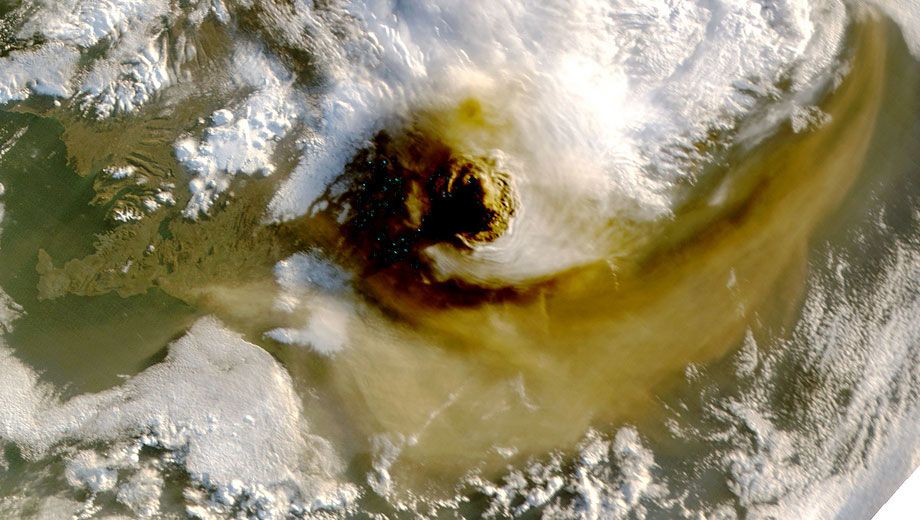MAP: Iceland's Grimsvotn volcano eruption: cloud to affect Australia-Europe flights

The latest ash cloud forecast maps from the London Volcanic Ash Advisory Centre about the Grimsvötn volcano eruption in Iceland paint a concerning picture for passengers flying to London and other UK airports -- plus Amsterdam, Copenhagen, Oslo, Stockholm and Paris.
Flights over the North Pole from Tokyo and Vancouver to all European destinations are likely to see extensive delays if they can skirt the ash cloud -- or diversions and cancellations if they can't.
Similarly, flights from the whole of East and Southeast Asia -- including Beijing, Seoul, Hong Kong, Bangkok and Singapore -- will likely experience delays and potential weight problems (meaning passengers and luggage may be left behind) as they try to avoid the ash cloud to the south.
Here's where the problems lie according to the Volcanic Ash Advisory Centre:
This map highlights the expected track of the volcanic ash plume as of 1200 GMT on Tuesday -- which is 2200 Sydney time on the same day.
Stretching well across the Arctic and polar regions and almost the entire UK, the band of potentially dangerous ash is likely to affect flights.
The red bands outline the Volcanic Ash Advisory Centre's aviation-related advisories for the FL200 flight level (20,000 feet), whereas the green bands are for the 35,000 feet altitude.
So green areas are potentially hazardous to fly through at altitude, whereas red areas are problematic to pass through for takeoff and landing.
The picture at 1800 GMT on Tuesday -- 4am Wednesday, Sydney time -- is even bleaker.
Covering a wider area from northern Canada, almost the entire UK and parts of Belgium, the Nertherlands, Denmark, Germany, Norway, Sweden and Russia, the wider spread of the red area is concerning.
The entire area may not be entirely off-limits, and authorities (not to mention airlines and passengers) are keen to avoid a repeat of last year, when the Eyjafjallajökull ash cloud shut down European airspace.
But there are special approvals required to fly through the areas from safety regulators -- which can only spell delays. Plus, with airline routes and aircraft plans carefully calculated to use the least possible fuel, diversions, delays and cancellations are likely too.
Take a look at this map from the ever-useful Great Circle Mapper (which every fan of maps should have bookmarked).
It shows the shortest path from various airports to London's Heathrow (LHR). Clearly, aircraft from Tokyo (NRT) and Vancouver (YVR) will have problems since they usually fly right through the ash cloud "red zone".
But look at the paths from Singapore (SIN), Hong Kong (HKG) and Los Angeles (LAX), and then compare those with the expected path of the ash cloud. Those flights will likely have to divert around the cloud, and with some of those destinations near the maximum range of the planes used on the routes, airlines and pilots may choose to load extra fuel or lighten their aircraft's load.
And that's a problem for passengers, because that means that luggage may be offloaded -- and passengers may be left behind. With the affected routes including virtually all the regular transit points from Australia to Europe, check with your airline and ensure your travel insurance will cover delays and compensation if needed.
Interestingly, Emirates' Dubai hub (DXB) looks to provide another geographical advantage for the Middle Eastern mega-carrier. With flight paths further to the south -- and long-range high-capacity aircraft like the Airbus A380 and Boeing 777-300ER that can easily reach London with a full load -- Emirates looks to be the Kangaroo Route airline that will have the fewest difficulties as a result.
Check back for updates
Australian Business Traveller will continue to monitor developments and will bring you the latest -- both here at www.ausbt.com.au and on Twitter: @AusBT.



Hi Guest, join in the discussion on MAP: Iceland's Grimsvotn volcano eruption: cloud to affect Australia-Europe flights